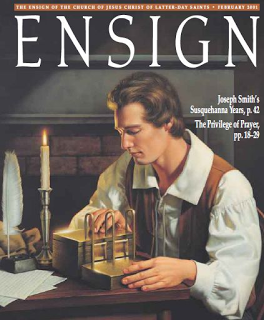https://www.lds.org/ensign/2015/10/joseph-the-seer?lang=eng
A section of the article addresses the significance of artistic interpretation of historical events. Here’s what the articles says:
Illustrating the Translation Process
The article then gives some examples of well-known art that has conveyed an interpretation of history that is not exactly supported by the historical accounts.
In my presentations, I show some additional examples. Here’s one that was on the cover of the Ensign itself a few years ago:
The article explains: “Artist’s rendition of Joseph Smith studying the plates. Joseph recalled that he “copied a considerable number” of characters from the plates. After he translated these characters “by means of the Urim and Thummim,” Martin Harris took the characters to Charles Anthon and other scholars to confirm the translation (Joseph Smith—History 1:62–64).
Although the article characterizes this painting as Joseph studying the plates, the painting is titled “By the Gift and Power of God” (which refers to translation) and has been used to illustrate articles about Joseph translating the plates. E.g., look at this issue of the Liahona: https://www.lds.org/bc/content/shared/content/english/pdf/language-materials/09690_eng.pdf?lang=eng
This painting and the one that follows are among those that have formed the historical narrative for millions of LDS. They convey the idea that Joseph translated the plates by looking at them, contrary to the historical evidence that he used a seer stone. The article explains how art is an interpretation, not a doctrinal or historical reality.
 For some reason, the online version of the article omits this painting to the right, but here’s what it says about it.
For some reason, the online version of the article omits this painting to the right, but here’s what it says about it.
Artist’s portrayal of Joseph Smith and Oliver Cowdery working on the translation of the Book of Mormon. Unlike what is depicted here, Oliver Cowdery stated that he did not see the plates until after the translation was finished. Witnesses of the process reported that during the translation, the plates were shielded from view, such as by being covered with a linen cloth.
__________________
It’s no wonder that millions of LDS have a particular mental image of the Book of Mormon as well. Look at the art that accompanies the Book of Mormon still today:
https://www.lds.org/scriptures/bofm/illustrations?lang=eng
I’ll discuss this in the next installment.
Source: Book of Mormon Concensus

